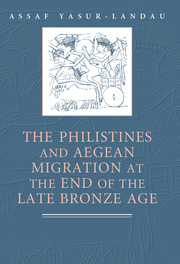Book contents
- Frontmatter
- Contents
- Acknowledgments
- INTRODUCTION
- 1 THE ARCHAEOLOGICAL IDENTIFICATION OF MIGRATION AND OTHER RANGES OF INTERREGIONAL INTERACTIONS
- 2 SETTING THE SCENE: THE MYCENAEAN PALATIAL CULTURE AND THE OUTSIDE WORLD
- 3 THE TWELFTH-CENTURY-BCE AEGEAN: POLITICAL AND SOCIAL BACKGROUND
- 4 PRECONDITIONS FOR MIGRATION
- 5 ALONG THE ROUTES
- 6 STRICTLY BUSINESS? THE SOUTHERN LEVANT AND THE AEGEAN IN THE THIRTEENTH TO THE EARLY TWELFTH CENTURY BCE
- 7 THE MATERIAL CULTURE CHANGE IN TWELFTH-CENTURY PHILISTIA
- 8 THE PHILISTINE SOCIETY AND THE SETTLEMENT PROCESS
- 9 A SHORT HISTORY OF THE AEGEAN IMMIGRATION TO THE LEVANT
- Bibliography
- Index
9 - A SHORT HISTORY OF THE AEGEAN IMMIGRATION TO THE LEVANT
Published online by Cambridge University Press: 04 August 2010
- Frontmatter
- Contents
- Acknowledgments
- INTRODUCTION
- 1 THE ARCHAEOLOGICAL IDENTIFICATION OF MIGRATION AND OTHER RANGES OF INTERREGIONAL INTERACTIONS
- 2 SETTING THE SCENE: THE MYCENAEAN PALATIAL CULTURE AND THE OUTSIDE WORLD
- 3 THE TWELFTH-CENTURY-BCE AEGEAN: POLITICAL AND SOCIAL BACKGROUND
- 4 PRECONDITIONS FOR MIGRATION
- 5 ALONG THE ROUTES
- 6 STRICTLY BUSINESS? THE SOUTHERN LEVANT AND THE AEGEAN IN THE THIRTEENTH TO THE EARLY TWELFTH CENTURY BCE
- 7 THE MATERIAL CULTURE CHANGE IN TWELFTH-CENTURY PHILISTIA
- 8 THE PHILISTINE SOCIETY AND THE SETTLEMENT PROCESS
- 9 A SHORT HISTORY OF THE AEGEAN IMMIGRATION TO THE LEVANT
- Bibliography
- Index
Summary
A LAND MUCH DIVIDED: THE WORLD THAT CREATED THE AEGEAN MIGRATION
The butterfly that launched a chain of events effecting the massive Aegean immigration to the Levant must have fluttered its wings in the thirteenth-century Mycenaean heartland.
The palatial civilization of the thirteenth century had all the necessary means to initiate virtually any form of interregional interaction (Chapter 2). The evidence from the Linear B tablets suggests that ships, human resources, knowledge about destinations, and funds were available, at least to the largest palaces, thus enabling them to engage in the most expensive and risky enterprises: international trade in raw materials and state-orchestrated migration.
The destination of this early colonization is still obscure. There is still no evidence of thirteenth-century settlement in the Levant or Cyprus, and while the evidence from western regions (e.g., Sicily, peninsular Italy, and Sardinia) may indicate some Aegean presence (e.g., artisans, traders), it hints at nothing nearing the scale suggested by the Pylos tablets. It may be, therefore, that this settlement was confined to the boundaries of the Aegean cultural sphere, somewhere in the vast area between the Ionian Islands and the western Anatolian coast.
The thirteenth-century geographical knowledge of destinations, technical skills for ship construction, and organizational abilities necessary to conduct maritime migration were probably not entirely lost after the changes in the political systems and patterns of rulership at the beginning of the twelfth century (Chapter 3). Moreover, the changing political climate of the LHIIIC period provided favorable conditions for migration.
- Type
- Chapter
- Information
- Publisher: Cambridge University PressPrint publication year: 2010



